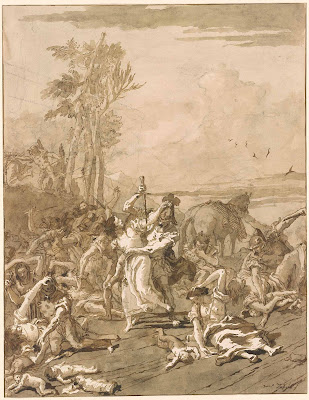 |
| Giambattista Tiepolo Maecenas presenting the Liberal Arts to Emperor Augustus 1743 oil on canvas Hermitage, Saint Petersburg |
"Perhaps the most congenial and equable end for an artist is that of being transformed into a color, like Daphne into laurel: this is what happened to Tiepolo in Proust. In the entire À la recherche du Temps Perdu, which teems with references to painting, there is never any mention of a work by Tiepolo. But the artist's name rings out three times – and each time in relation to a different woman: Odette, the Duchess of Guermantes, and Albertine. The three women about whom Marcel fantasized the most, the ones who made him suffer most (even when he took on the character of Swann) – the women who accompanied his life like a long, glittering tripartite wake."
 |
| Giambattista Tiepolo Seated Man & Woman with Pitcher ca. 1755 oil on canvas National Gallery, London |
"For Proust, Tiepolo was first and foremost Odette's robes. In the eyes of this very young and stubborn worshipper, none of the outfits with which Madame Swann appeared in society were remotely comparable to the "marvelous robe in crêpe de Chine or silk, old rose, cherry, Tiepolo pink, white, mauve, green, red, yellow, plain or patterned, with which Madame Swann had eaten breakfast and was about to take off." Like a faithful fanatic, Marcel deplored the fact that she did not go out dressed that way – and remembered that then Odette "would laugh, to make fun of his ignorance or with pleasure for the compliment." Perhaps between Odette and Marcel there would never more be a moment of such intimacy, protected by the color that stood out in her collection of robes: "Tiepolo pink."
 |
| Giambattista Tiepolo Triumph of Manius Curius Dentatus ca. 1730 oil on canvas Hermitage, Saint Petersburg |
"With the Duchess of Guermantes, years later, another Tiepolesque epiphany was to occur. This time it was public and illuminating, when the duchess presented herself with "her evening mantle, in a magnificent Tiepolo red." And so the duchess could remain petrified in a tableau vivant where Marcel himself offered to serve as her ensign – and that one day would expand to include all the vast population of the Recherche: "Erect, isolated, with her husband and me at her side, the duchess was on the left hand side of the stairway, already wrapped in her mantle à la Tiepolo, a ruby-studded clasp around her neck, devoured by the eyes of women and men trying to guess the secret of her elegance and beauty."
 |
| Giambattista Tiepolo Figures studying Carved Relief on Altar ca. 1740-45 drawing Hermitage, Saint Petersburg |
 |
| Giambattista Tiepolo Three Elders, Two Youths, and a Boy ca. 1740-44 drawing Hermitage, Saint Petersburg |
"Finally, there was the Tiepolo of Albertine, brought back to life – this time – in the lining of a robe, as if in some Buddhist metempsychosis, and once more permeated by the aura of the artist's birthplace, Venice, but no longer flaunted as an emblem of sovereignty. Now it would live in semiclandestinity, concealed beneath the blue and gold of the Fortuny robe that Albertine loved. As Marcel's gaze gradually penetrated that deep blue, the color "changed into malleable gold, those same transmutations that, ahead of the gondola moving forward, change the light blue of the Canal Grande into glittering metal," until the metamorphosis subsided in the "sleeves lined with a cherry pink so peculiarly Venetian as to be called Tiepolo pink."
– from Tiepolo Pink by Roberto Calasso, translated by Alastair McEwen (Knopf, 2009)
 |
| Giandomenico Tiepolo The Dressmaker late 18th century drawing Morgan Library, New York |
 |
| Giandomenico Tiepolo The Quack Dentist late 18th century drawing Morgan Library, New York |
 |
| Giandomenico Tiepolo Hercules and Antaeus late 18th century drawing Morgan Library, New York |
 |
| Giandomenico Tiepolo God the Father carried by Angels late 18th century drawing Morgan Library, New York |
 |
| Giandomenico Tiepolo Sketches of Three Heads late 18th century drawing Morgan Library, New York |
 |
| Giandomenico Tiepolo Sketches for The Death of Hyacinth late 18th century drawing Morgan Library, New York |
 |
| Giandomenico Tiepolo Massacre of the Innocents late 18th century drawing Morgan Library, New York |
 |
| Giandomenico Tiepolo Holy Family on the Flight into Egypt with Angels late 18th century drawing Morgan Library, New York |
 |
| Giandomenico Tiepolo Centaur and Faun in Landscape late 18th century drawing Morgan Library, New York |